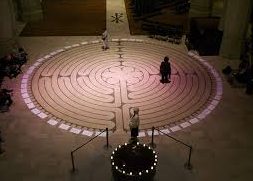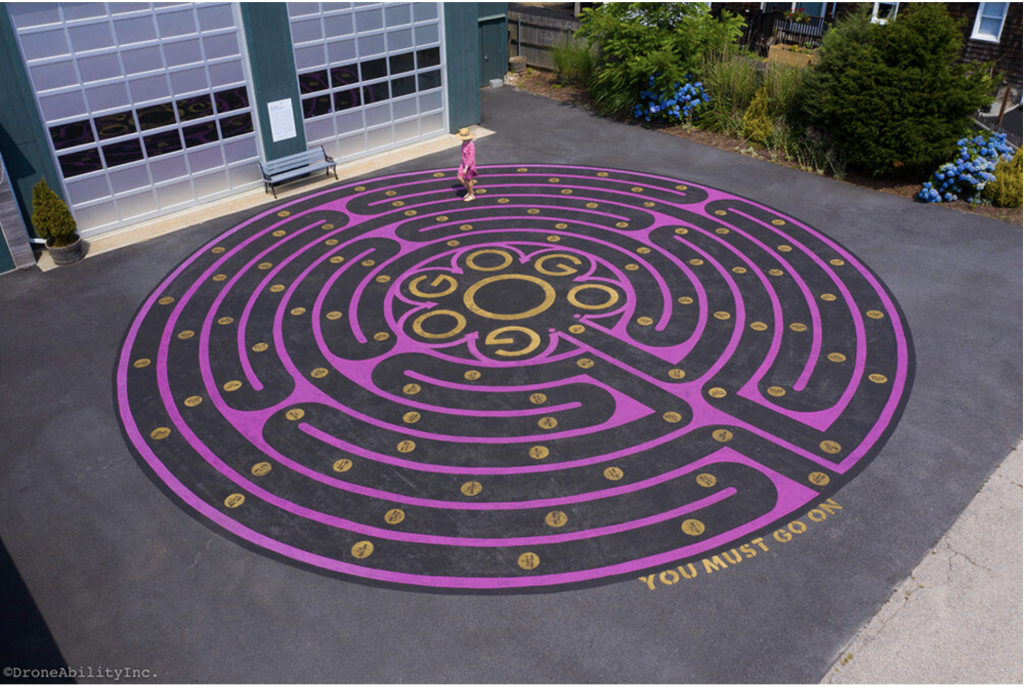
Take a breath: Walking the labyrinth for stress reduction
We have managed to thrive during the tumult that is the holiday season. As we enter a New Year, filled with both hope and uncertainty, we may need a gentle prompt to reclaim mindfulness. The action of walking the labyrinth can be seen as a metaphorical journey. It gets us out of our heads and into our hearts, from the stress of the day-to-day grind and into a state of peace. Walking the labyrinth for stress reduction is as easy as breathing in and breathing out. It is perfect for maintaining peace of mind.
Walking the Labyrinth for Stress Reduction
A labyrinth is a walking meditation that centers our mind and brings us calm. At first glance it may seem like a puzzling and confusing pathway of twists and turns. But the labyrinth it is a unicursal path. There is only one way in and one way out. If we simply move ahead we will find the way to the center and the way back home again. This is the gift the labyrinth offers: a reminder that, if we keep an eye on our goal despite the twists and turns, we eventually will reach our goals. As we mindfully walk the labyrinth for stress reduction our breathing slows into a gentle rhythm, our heart beat slows with our breath, and we are suffused with a sense of peace.
History of the Labyrinth

Labyrinths are ancient. The image was impressed into ancient Roman coins. The Minoan/Greek legend of the hero, Jason, doing combat with the Bull headed Minotaur takes place in a labyrinth. Labyrinthian paths were constructed into the floors of cathedrals, like Chatres in France. They were used by pilgrims to travel a metaphorical pilgrimage to Jerusalem, the gift being penance and grace. Labyrinths are having a resurgence in popularity. Modern labyrinths can be found in churches as well as spas, retreats, hospitals and colleges.
Reverend Lauren Artress of Grace Cathedral in San Francisco is credited with launching the movement. Her book, Walking A Sacred Path: Rediscovering the Labyrinth as a Sacred Tool published n 1995. She continues to offer trainings and leads retreats through Veriditas.org.
The role of the Labyrinth in stress reduction
Stress and its bi-products affect young and old alike. The resulting symptoms adversely affect our communities Here are just a few statistics:
- The by-products of stress cost businesses $200 billion a year in lost productivity
- 60% of Americans stress over eaters
- Impairs immune system, memory and learning ability
- 75-90% of doctor visits are due to stress. Suppressed anger increases violent behavior and impaired judgment.
- 1-5 children evince psychological stress related problems
Through the act of walking meditation, walking the labyrinth for stress reduction assists in addressing stress. It helps shift our awareness out of our heads, a Beta state of consciousness, and into our hearts, a Theta state of consciousness. In the scholarly article “Effective Short Term Therapy,” by Neal Harris, the relaxed state of mind achieved as we move from Beta to Theta state is called, “Brain Synchrony.” The labyrinth is a gentle, non-threatening and non-invasive way of bringing a client to “Center,” or into a state of Brain Synchrony.
Get more labyrinth
Using the labyrinth as a guide for walking meditation is an easy, non-invasive, way to center mind, body and spirit and give yourself the gift of peace especially during these trying times. Learn to your own labyrinth spring renewal ritual as The Daily Key Celebrates spring with a labyrinth walk,
Or, go to www.worldwidelabyrinthlocator.com to find labyrinths in your area open for public use.
For Rhode Island locals, the Labyrinth form has inspired artist Robin Crocker’s site specific environmental installation she calls “Beckett’s Maze: Go On,” now on view at The Jamestown Art Center in Jamestown RI. This ephemeral installation is designed to fade, so if you are in the area, do take the opportunity to walk it while it lasts.

a Site-specific Ephemeral Environmental Installation by artist Robin Crocker
Located in the Jamestown Arts Center parking lot, 45 feet in diameter
Photo credit Drone Ability
Cris McCullough is a Certified Labyrinth Facilitator in Newport , RI who offers guided walks and trainings, for information on classes or guided walks go to www.soulwisdomhealing.com.



 Snow Labyrinth at Easton’s Beach Newport RI Cris McCullough
Snow Labyrinth at Easton’s Beach Newport RI Cris McCullough  Snow Labyrinth at Easton’s Beach Newport RI Cris McCullough
Snow Labyrinth at Easton’s Beach Newport RI Cris McCullough